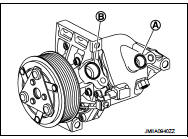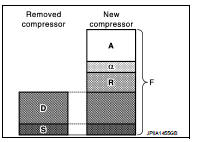Nissan Juke Service and Repair Manual : Lubricant
Description
MAINTENANCE OF LUBRICANT LEVEL
The compressor lubricant is circulating in the system together with the refrigerant. It is necessary to fill compressor with lubricant when replacing A/C system parts or when a large amount of refrigerant leakage is detected. It is important to always maintain lubricant level within the specified level. Otherwise, the following conditions may occur.
• Insufficient lubricant amount: Stuck compressor • Excessive lubricant amount: Insufficient cooling (caused by insufficient heat exchange)
Name : A/C System Oil Type R
Inspection
If a compressor is malfunctioning (internal noise, insufficient cooling), check the compressor oil.
1.COMPRESSOR OIL JUDGMENT
1. Remove the compressor. Refer to HA-32, "COMPRESSOR : Removal and Installation".
2. Sample a compressor oil and judge on the figure.

Judgement result 1>>Replace compressor only.
Judgement result 2>>Replace compressor and liquid tank.
Perform Lubricant Return Operation
CAUTION:
If a large amount of refrigerant or lubricant leakage is detected, never perform
lubricant return operation.
1. Start the engine and set to the following conditions.
• Engine speed: Idling to 1,200 rpm
• A/C switch: ON
• Fan speed: Maximum speed set
• Intake door position: Recirculation
• Temperature setting: Full cold
2. Perform lubricant return operation for approximately 10 minutes.
3. Stop the engine.
4. Lubricant return operation is complete.
Lubricant Adjusting Procedure for Components Replacement Except Compressor
Fill with lubricant for the amount that is calculated according to the following conditions.
Example: Lubricant amount to be added when replacing evaporator and liquid tank [m (Imp fl oz.)] = 35 (1.2) + 5 (0.2) + α

Lubricant Adjusting Procedure for Compressor Replacement
1. Drain lubricant from removed compressor and measure lubricant amount.
1. Drain lubricant from high-pressure port (A) and low-pressure port (B) while rotating magnet clutch.
2. Measure total amount of lubricant that is drained from removed compressor.

2. Drain lubricant from a new compressor that is calculated according to the following conditions.
Amount to be drained (A) [m (Imp fl oz.)] = F − (D
+ S + R + α)
F : Lubricant amount that a new compressor
contains [120 (4.2)]
D : Lubricant amount that is drained from removed
compressor
S : Lubricant amount that remains inside of removed
compressor [20 (0.7)]
R : Lubricant amount to be added according to
components that are removed except compressor
α : Lubricant amount that is recycled together
with refrigerant during recycle operation

CAUTION: If lubricant amount that is drained from removed compressor is less than 60 m (2.1 Imp fl oz.), perform calculation by setting “D” as 40 m (1.4 Imp fl oz.).

Example: Lubricant amount to be drained from a new compressor when replacing compressor and liquid tank [m (Imp fl oz.)] [D = 60 (2.1), α = 5 (0.2)] 120 (4.2) − [60 (1.6) + 20 (0.7) + 5 (0.2) + 5 (0.2)] = 30 (1.0)
3. Install compressor and check the operation.
 Refrigerant
Refrigerant
Description
CONNECTION OF SERVICE TOOLS AND EQUIPMENT
1. Shut-off valve
2. A/C service valve
3. Recovery/recycling/recharging
equipment
4. Vacuum pump
5. Manifold gauge set
6. Refrigerant ...
 Performance test
Performance test
Inspection
INSPECTION PROCEDURE
1. Connect recovery/recycling/recharging equipment (for HFC-134a) or manifold
gauge.
2. Start the engine, and set to the following condition.
Test condition
...
Other materials:
DTC Index
*1: 1st trip DTC No. is the same as DTC No.
*2: This number is prescribed by SAE J1979/ ISO 15031-5.
*3: In Diagnostic Test Mode II (Self-diagnostic results), this number is
controlled by NISSAN.
*4: The troubleshooting for this DTC needs CONSULT-III.
*5: When the fail-safe operation ...
Vehicle jerks during
Description
The vehicle jerks when ESP function, TCS function, ABS function, EBD function
or brake limited slip differential
(BLSD) function operates.
Diagnosis Procedure
1.CHECK SYMPTOM
Check that the vehicle jerks when ESP function, TCS function, ABS function,
EBD function or brake limite ...
Filament
Inspection and Repair
INSPECTION
1. When measuring voltage, wrap tin foil around the top of the negative
probe. Then press the foil against the wire with your finger.
2. Attach probe circuit tester (in Volt range) to middle portion of
each filament.
3. If a filament is burned out, circuit ...
